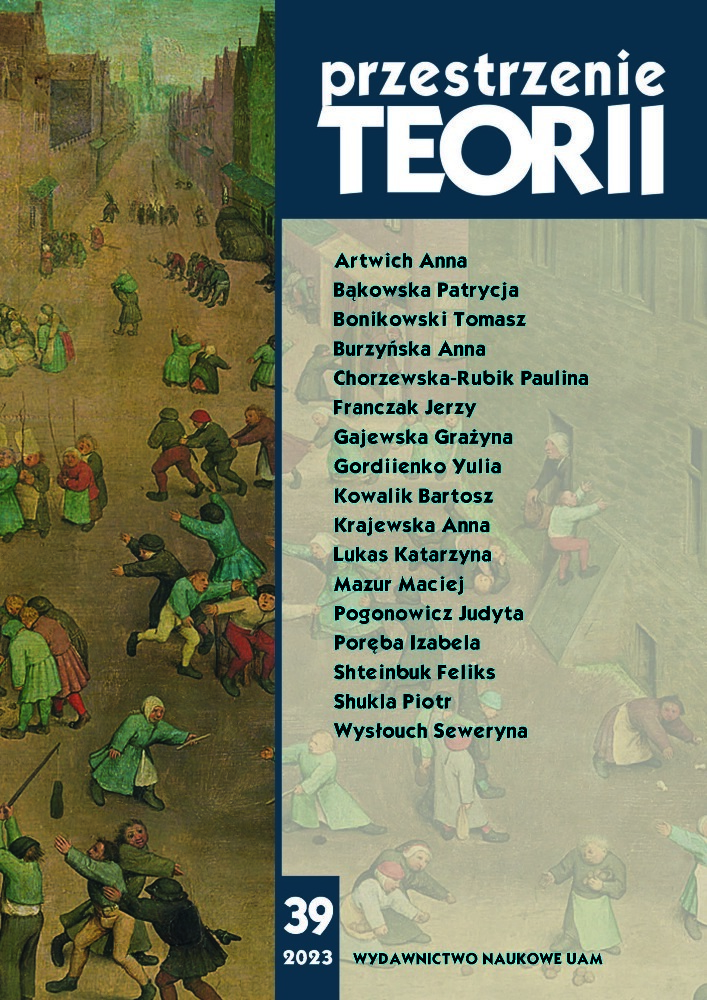Abstract
Lech Majewski’s The Mill and the Cross (2011) is a full-length feature film, a screen adaptation of Pieter Bruegel’s painting The Way of the Cross (1564). Majewski proves to be an excellent interpreter of Bruegel’s art, whom he considers a philosopher, an epic, and a poet. He relies on the research of Michael F. Gibson, and in his plotting he draws on a long-standing tradition of literary experience and digital technology (without this, it would have been impossible to faithfully reproduce the overall plan and realities of the painting). Majewski exposes the palimpsest nature of the narrative and shapes the film like a contemporary novel of space. In order to make the ideas of the screened painting comprehensible and to emphasize the fictionality of the depicted world, he introduces various versions of “literature about literature”. In the film, he perfectly integrates painterly features (word reduction, stop motion, long static camera shots) and literary features (the structure of an episodic novel of manners).
References
Arnheim R., Sztuka i percepcja wzrokowa. Psychologia twórczego oka, przeł. J. Mach, Warszawa 1978.
Bachtin M., Czas i przestrzeń w powieści, przeł. J. Faryno, [w:] Wokół problemów realizmu, red. A. Lam, Warszawa 1977.
Bakuła B., Człowiek jako dzieło sztuki. Z problemów metarefleksji artystycznej, Poznań 1994.
Bianco D., Bruegel, przeł. H. Borkowska, Warszawa 2010.
Danek D., O cytatach struktur (quasi-cytatach), w: tejże, O polemice literackiej w powieści, Warszawa 1972.
Genette G., Palimpsesty. Literatura drugiego stopnia, przeł. T. Stróżyński i A. Milecki, Gdańsk 2014.
Gibson M.F., „Młyn i krzyż”. „Droga krzyżowa” Pietera Bruegla, przeł. A. Topornicka, [w:] M.F. Gibson, L. Majewski, Bruegel, „Młyn i krzyż”, Olszanica 2010.
Hagen R-M. i R., Pieter Bruegel Starszy (około 1525–1569), przeł. E. Tomczyk, Warszawa 2005.
Hendrykowski M., Język ruchomych obrazów, Poznań 1999.
Hendrykowski M., Współczesna adaptacja filmowa, Poznań 2014.
Kayser W., Postawy i formy epickie, przeł. R. Handke, w: Teoria form narracyjnych w niemieckim kręgu językowym. Antologia, oprac. R. Handke, Kraków 1980.
Krzemińska A., Słowa pod słowami, „Polityka” 2022, nr 52.
Lebecka M., Lech Majewski, Warszawa 2010.
Lessing G.E., Laokoon, czyli o granicach malarstwa i poezji, przeł. H. Zymon-Dębicki, oprac. M. Mencfel, Kraków 2012.
Majewski L., Dodatki specjalne, [w:] Młyn i krzyż. Film Lecha Majewskiego, DVD, Blaq Out Galapagos 2012.
Majewski L., Pejzaż intymny. Rozmowy autobiograficzne o świecie i o sztuce, Poznań 2017.
Majewski L., Scenariusze, t. 3, Poznań 2018.
Majewski L., Ukryty język symboli w sztuce, [dostęp: 7.12.2022].
Majewski L., Ukryty język symboli. Esencje i notatki o sztuce, religii, liczbach i miastach, Poznań 2020.
Nowakowski J., W stronę raju. O literackiej i filmowej twórczości Lecha Majewskiego, Poznań 2012.
Okoń W., Sztuka i narracja. O narracji wizualnej w malarstwie polskim II połowy XIX wieku, Wrocław 1988.
Poprzęcka M., Czas wyobrażony. O sposobach opowiadania w polskim malarstwie XIX w., Warszawa 1986.
Reimann-Czajkowska A., Film „Młyn i krzyż” Lecha Majewskiego wobec malarskiego pierwowzoru Pietera Bruegla, [w:] Piękno zespolić ze sobą. Korespondencja na styku sztuk, red. K. Klauza, J. Cieślik-Klauza, Białystok 2015.
Wiegandt E., Przestrzeń artystyczna a konstruowanie tradycji, w: tejże, Niepokoje literatury. Studia o prozie polskiej XX wieku, Poznań 2010.
Żywot łazika z Tormesu, przeł. M. Mann, wstęp E. Skłodowska, Warszawa 1988.
License
Copyright (c) 2023 Seweryna Wysłouch

This work is licensed under a Creative Commons Attribution-NonCommercial-NoDerivatives 4.0 International License.
Authors
Authors of texts accepted for publication in Przestrzenie Teorii are required to complete, sign and return to the editor's office the Agreement for granting a royalty-free license to works with a commitment to grant a CC sub-license.
Under the agreement, the authors of texts published in Przestrzenie Teorii grant the Adam Mickiewicz University in Poznań a non-exclusive, royalty-free license and authorize the use of Attribution-NonCommercial-NoDerivatives 4.0 International (CC BY-NC-ND 4.0) Creative Commons sub-license.
The authors retain the right to continue the free disposal of the work.
Users
Interested Internet users are entitled to use works published in Przestrzenie Teorii since 2015, for non-commercial purposes only, under the following conditions:
- attribution - obligation to provide, together with the distributed work, information about the authorship, title, source (link to the original work, DOI) and the license itself.
- no derivatives - the work must be preserved in its original form, without the author's consent it is not possible to distribute the modified work, such as translations, publications, etc.
Copyrights are reserved for all texts published before 2015.
Miscellaneous
Adam Mickiewicz University in Poznań retains the right to magazines as a whole (layout, graphic form, title, cover design, logo etc.).

